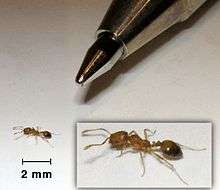Monomorium
Monomorium is a genus of ants in the subfamily Myrmicinae. As of 2013 it contains about 396 species.[1] It is distributed around the world, with many species native to the Old World tropics.[2] It is considered to be "one of the more important groups of ants," considering its widespread distribution, its diversity, and its variety of morphological and biological characteristics.[3] It also includes several familiar pest species, such as the pharaoh ant (M. pharaonis) and the flower ant (M. floricola).[3]
| Monomorium | |
|---|---|
 | |
| Monomorium pharaonis, and the tip of a pen for scale comparison | |
| Scientific classification | |
| Kingdom: | Animalia |
| Phylum: | Arthropoda |
| Class: | Insecta |
| Order: | Hymenoptera |
| Family: | Formicidae |
| Subfamily: | Myrmicinae |
| Tribe: | Solenopsidini |
| Genus: | Monomorium Mayr, 1855 |
| Type species | |
| Monomorium monomorium Bolton, 1987 | |
| Species | |
|
about 396 | |
| Synonyms | |
|
Antichthonidris | |
Description
This genus is very diverse in morphology, with species of many shapes and sizes that "do not necessarily even remotely resemble one another" at first glance.[3]
While the worker caste is monomorphic in some species, in others it is polymorphic. In some species the workers are minute, in others they are rather large. Large, multifaceted eyes are common, but M. inusuale has much reduced eyes, as do some species from Africa. The sting is always functional.[4]
Taxonomy
This large genus was further expanded in 2007, when the genera Nothidris, Epelysidris, and Phacota were synonymized with Monomorium. The small genera Anillomyrma, Megalomyrmex, and perhaps Bondroita should possibly also be included in Monomorium.[4]
The exact boundaries of the genus are yet to be determined. It has no distinct morphological trait that sets it apart from other genera in the tribe Solenopsidini. If cladistics were strictly applied, all Solenopsidini would be grouped in the single genus Solenopsis, but the tribe lacks a strong synapomorphy. Monomorium as it currently stands is paraphyletic, but it is used as a provisional group. Similar problems are found in the genera Camponotus and Leptothorax.[5]
Biology
Most ants of this genus nest in rotting wood, under rocks, or in the soil.[2] Some species are scavengers, while others are seed collectors.[6] Many species have venom containing alkaloids, which they use as a defense from predators.[7] Besides its morphological variation, the genus is also variable in chromosome number, with 2n of 16 to 70 recorded.[8]
Distribution
As of 2006, 36 species are described from Madagascar, 19 of which were described in that year alone. About 43 species are known from Australia and 30 from Arabia.[5]
Selected species
- Monomorium antarcticum
- Monomorium bidentatum
- Monomorium chinense
- Monomorium delabiei Fernández, 2007
- Monomorium dentatum
- Monomorium denticulatum
- Monomorium effractor
- Monomorium fieldi
- Monomorium floricola – flower ant
- Monomorium hospitum
- Monomorium inquilinum
- Monomorium inusuale Fernández, 2007
- Monomorium kondratieffi Sharaf & Aldawood, 2013[9]
- Monomorium minimum – little black ant
- Monomorium monomorium Bolton, 1987
- Monomorium noualhieri
- Monomorium pergandei
- Monomorium pharaonis – pharaoh ant
- Monomorium rubriceps
- Monomorium santschii
- Monomorium smithi
- Monomorium talbotae
References
- Monomorium. AntWeb. v5.1.17.
- Aldawood, A. S. and M. R. Sharaf. (2011). Monomorium dryhimi sp. n., a new ant species (Hymenoptera, Formicidae) of the M. monomorium group from Saudi Arabia, with a key to the Arabian Monomorium monomorium-group. ZooKeys 106, 47-54.
- Heterick, B. E. (2003). Two new Australian Monomorium Mayr (Hymenoptera: Formicidae), including a highly distinctive species. Australian Journal of Entomology 42(3), 249-53.
- Fernández, F. (2007). Two new South American species of Monomorium Mayr with taxonomic notes on the genus. In: Snelling, R. R., et al. (eds). Advances in ant systematics (Hymenoptera: Formicidae): homage to E. O. Wilson – 50 years of contributions. Memoirs of the American Entomological Institute 80, 128-45.
- Heterick, B. (2006). A revision of the Malagasy ants belonging to Genus Monomorium Mayr, 1855 (Hymenoptera: Formicidae). Proceedings of the California Academy of Sciences 57(3), 69-202.
- Mashaly, A. M. A., et al. (2010). Source, optimal dose concentration and longevity of trail pheromone in two Monomorium ants (Formicidae: Hymenoptera). Journal of King Saud University-Science 22(1), 57-60.
- Jones, T. H., et al. (2003). The venom alkaloids from some African Monomorium species. Journal of Chemical Ecology 29(12), 2721-27.
- Lorite, P., et al. (2002). Chromosome numbers in Spanish Formicidae (Hymenoptera) IV. New data of species from the genera Camponotus, Formica, Lasius, Messor, and Monomorium. Sociobiology 40(2), 331-42.
- Sharaf, M. R.; Aldawood, A. S. (2013). "First occurrence of the Monomorium hildebrandti-group (Hymenoptera: Formicidae), in the Arabian Peninsula, with description of a new species M. kondratieffi n. sp". Proceedings of the Entomological Society of Washington. 115 (1): 75–84. doi:10.4289/0013-8797.115.1.75.
External links
- Monomorium. Japanese Ant Image Database.
Further reading
| Wikimedia Commons has media related to Monomorium. |
- Mashaly, A. M. A. (2010). Monomorium ant's trail pheromones: Glandular source, optimal concentration, longevity and specificity. Journal of Asia-Pacific Entomology 13(1), 23-26.
- Mayr, G. (1855). Formicina austriaca. Beschreibung der bisher im oesterreichischen Kaiserstaate aufgefundenen Ameisen nebst Hinzufuegung jener in Deutschland, in der Schweiz und in Italien vorkommenden Ameisen. Verhandlungen des Zoologisch-Botanischen Vereins in Wien 5, 273-478.